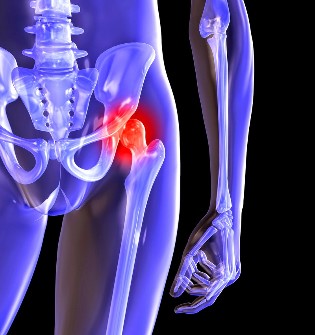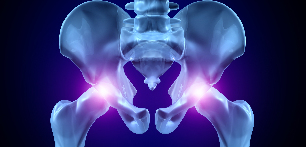Osteoarthritis of the hip — degenerated-degenerative pathology that is characterized by destruction of hyaline cartilage. The disease develops gradually, accompanied by the syndrome of pain and decreased range of motion. In the absence of medical intervention at the initial stage of osteoarthritis a few years later, occurs an atrophy of the muscles. Damaged by a member is shortened, and the concretion of the joint space leads to a total or partial refusal of the paralysis of the hip. The causes of the pathology become previous injuries, curvature of the spine, the system of musculo-skeletal diseases.

Osteoarthritis is usually diagnosed in middle-aged patients and the elderly. The diagnosis is billed on the basis of the results of research tools — x-ray, MRI, ct, arthroscopy. The treatment of pathology 1 and 2 degree of gravity is conservative. Upon detection of ankylosis or of the ineffectiveness of drug treatment is carried out a surgical operation (arthrodesis, prosthesis).
The mechanism of development of pathology
The hip joint form the two bones — the iliac and femoral. The lower part of the iliac bone presented his body, which is involved in the texture of the thigh, forming the upper division of the cup. During the movement of the dimple joint immobile, and that the femoral head can move freely. This "seal" feature of the hip joint allows him to bend, stretch, turn, contributes to the abstract, put the thighs. Smooth sliding of the articular structures provides smooth, elastic, elastic hyaline cartilage lining the socket and the head of the femur. Its main features — the redistribution of charges in movement, alert, quick of clothing of bone tissue.

Under the influence of internal or external factors disturbed trophic of the cartilage. It has not the own of the circulatory system — nutrients to tissues provides the synovial fluid. With osteoarthritis, it thickens, becomes sticky. The shortage of nutrients causes the drying out of the surface of hyaline cartilage. It was covered with cracks, which leads to the continuation of the micro injuries to the tissues during flexion or extension of the hip. The cartilage is thinner, and lose their properties subject to amortization. To "adapt" to an increase of the pressure, deformation of the bones. But in the context of the deterioration of the metabolism in the tissue are progressing in a manner destructive-degenerative changes.
The causes and the triggering factors
Idiopathic or primary osteoarthritis develops without any reason. It is believed that the destruction of the cartilage tissue occurs due to natural aging of the body, acceleration of the regeneration process, reduce the production of collagen and other compounds necessary for the full regeneration of the structures of the hip joint. Secondary osteoarthritis occurs on a background already present in the body of the pathological condition. The most common reasons secondary to the disease are:
- prior to the accident of the equipment damage, tendon, muscle tears, their remoteness from the marrow of the foundation, fractures, dislocations;
- developmental disorders of the joint, the dysplastic disorders;
- autoimmune disease — rheumatoid, reactive, psoriatic arthritis, systemic lupus erythematosus;
- non-specific inflammatory disease, for example, purulent arthritis;
- of particular infections — gonorrhea, syphilis, brucellosis, uréaplasma, trichomoniasis, tuberculosis, osteomyelitis, encephalitis;
- abnormal functioning of the endocrine system;
- degenerate-dystrophic pathology — osteochondropathy of the femoral head;
- hypermobility of the joints due to the production "beyond the power" of collagen, causing the excess of mobility, weakness of the ligaments.
Because the cause of development of osteoarthritis may become a hemarthrosis (bleeding into the joint cavity of the hip), the causing factors include the violation of hematopoiesis. The conditions prior to the onset of the disease are excess weight, excessive exercise, a sedentary way of life. Its development lead to poor organization of the sport training, the deficiency in the supply of micronutrient-rich foods, giraud - and water-soluble vitamins. Post-operative osteoarthritis occurs many years after the surgical intervention, especially if it is accompanied by an excision large amount of tissue. Hip osteoarthritis cannot be inherited. But the presence of certain innate characteristics of (disorder of the metabolism, the structure of the skeleton), the likelihood of its development is substantially increased.
The symptoms
The main symptoms of osteoarthritis of the hip pain when walking in the region of the hip, of the knee joint. The man suffers from the stiffness of movement, causes stiffness, especially in the morning. To stabilize the joint, the patient begins to limp, is changing its approach. With time, due to muscle atrophy and deformity of the joint of the lower limb considerably shortened. Another feature of the pathology — the limitation of the derivation of the hip. For example, the difficulties arise when you try to sit on a stool, legs apart in hand.

Even "launched" OSTEOARTHRITIS can be cured at home! Just don't forget once per day spread out this...
For osteoarthritis of the first degree of severity characterized by recurrent pain occurring after an intense physical effort. They are located in the area of the joint and disappear after a long period of rest.
With osteoarthritis of the second degree of the hip of the connection, the severity of the pain increases. The unpleasant sensations occur even in a resting state, the spread of the thigh and the groin, are reinforced during the rise of the severity or the increase of the motor activity. To eliminate the pain in the hip joint, the person begins to barely noticeable of a limp. Highlights the restriction of movement in the joint, especially in abduction and internal rotation of the hip.
Osteoarthritis in the third degree is characterized by permanent severe pain. When driving is difficult, this is why, during the walk of the man is obliged to use a cane or crutches. Because of the weakness outside the femoral muscle occurs a shift pelvic bone to the prior plan. For the clearing of the incident, the shortening of the leg ill during a trip leans in the direction of the injured leg. This causes a strong displacement of the center of gravity and the increase of the load on the joint. At this stage of the osteoarthritis develops expressed ankylosis of the joint.
| The degree of | The radiographic signs |
| The first | The changes in odds are not drastically. Joint of the slit moderately, unevenly shrunken, missing the destruction of the surface of the thigh. On the outside or on the edge of the cup there are small bony growths |
| The second | The height of the joint space greatly reduced because of its uneven consolidation. The head of the hip is shifted up, distorted, enlarged, its edge is serrated. The bony growths form on the internal surface and external edges of the joint in the pit |
| The third | There is total or partial, of the concretion of the joint space. The head of the femur is strongly expanded. Several of the bony growths are found on the surface of the acetabulum |
The diagnosis
When a diagnosis the doctor takes into account the clinical manifestations of the pathology, medical history, the results of the external inspection of the patient, and instrumental. The most informative x-ray. With its aid is assessed the condition of the hip joint, is installed on the stage of its flow, the degree of damage to the cartilage tissue, and, in some cases, the cause of development. If cervical-diaphyseal node increased, and vertluzhnoj the basin tilted and flattened, with a high probability, we can assume dysplastic congenital alteration of the joint. The disease of Perthes indicates deteriorated the shape of the bones of the hip. The x-ray can vyvit post-traumatic osteoarthritis, despite the lack of history prior to the illness or injury. We also use other diagnostic methods:
- The CT allows you to discover the averaging of the edges of plates formed of osteophytes;
- The MRI is carried out to assess the state of connective tissue structures and the degree of their involvement in the disease process.
If necessary, the inner surface of the joint is subjected to a study on arthroscopic tools. The differential diagnosis is carried out to the exclusion of the knee, lumbosacral or osteoarthritis. Pain in osteoarthritis can hide under the clinical manifestations of the syndrome, nerve root, caused by the denial or the inflammation of the nerve. To exclude neurogenic pathology generally using a series of tests. Osteoarthritis of the hip is necessarily differentiated from the top of bursitis of the hip, Ankylosing spondylitis, reactive arthritis. For the exclusion of auto-immune diseases are conducted biochemical studies of blood and synovial fluid.
Surgery
The ineffectiveness of conservative treatment silt diagnosis of complications of the pathology of the operation. Restore the cartilage tissue in the damaged joint osteoarthritis, surgery of the prosthesis is impossible, but with the right approach to treatment, the observance of all medical requirements, managed by a good way of life, gymnastics, courses of massage, reception of vitamins and good nutrition, you can stop the process of the defeat and destruction of the cartilage and joints of the hip.
































